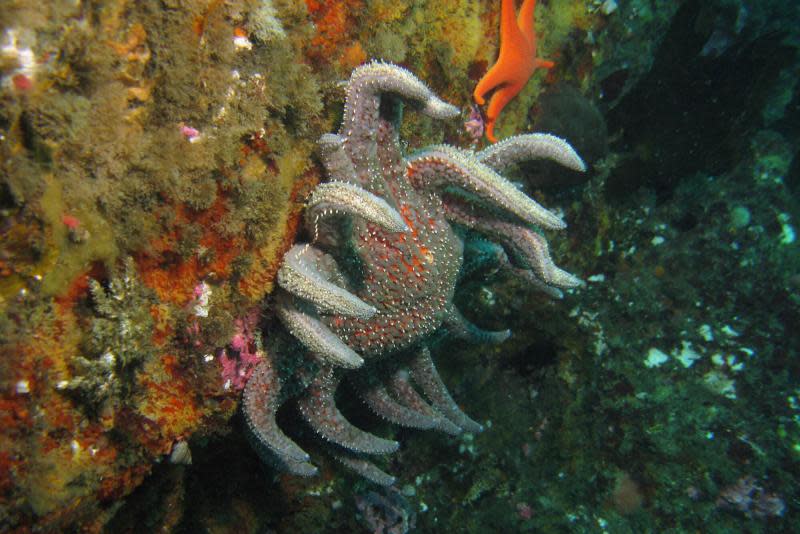Sunflower sea star, once a common sight off Oregon Coast, proposed for federal protection

Government officials proposed Wednesday to list the sunflower sea star, once a common sight on the Pacific coast and a key species for Oregon’s nearshore ecosystem, as threatened under the federal Endangered Species Act.
The National Marine Fisheries Service noted the sharp decline of one of the world’s largest sea stars, likely due to warming ocean waters caused by climate change, in its proposal for federal protection.
The main threat to the species, which can grow to 3 feet across and have up to 20 arms, is a lethal pathogen that causes sea star wasting syndrome, which killed more than 90% of sunflower sea stars from 2013 to 2017 in what is considered the largest marine wildlife disease outbreak on record.
“Sea stars that contract the syndrome become lethargic, develop lesions, lose their arms, and within days disintegrate into gooey masses,” NOAA Fisheries said in a news release.
Read more:Sea stars could help protect kelp forests, new study shows
The agency is requesting public comment on the listing for the next 60 days and could finalize the listing in a year.
The loss of the orange, red and purple marine invertebrates has already had a significant impact on the Oregon Coast’s nearshore environment.
Without sea stars, sea urchin numbers have exploded and wrought significant damage on kelp forests, which are critical habitat for a wide variety of species including invertebrates, fish, whales and birds.
Since 2017, the species has been rare south of Washington state and has disappeared almost entirely from southern California shores, such as the Channel Islands.
Syndrome linked to warming water
Scientists said that wasting syndrome appears due to a warming ocean, noting that outbreaks coincided with marine heatwaves. The eastern 2014 to 2016 Pacific Marine heatwave — often referred to as “The Blob” — coincided with several years of a wasting syndrome outbreak and the die-off observed in sunflower sea stars, officials said.
“The science indicates that warmer temperatures and other stressors fueling disease are pushing this species towards an elevated risk of extinction,” said Chris Yates, assistant regional administrator for protected resources in NOAA Fisheries’ West Coast Region.
Sea stars have fared better in cooler northern waters off shorelines in Alaska, British Columbia and the Salish Sea in the Pacific Northwest.
What would federal listing accomplish?
By listing the species, NOAA said it could look for ways to conserve the species.
The Center for Biological Diversity, which filed the petition that led to the proposed listing, said reducing water pollution, ocean dredging, shoreline armoring and other coastal development projects could be actions the agency could take.
Even so, officials acknowledged that without stopping ocean warming, there is only so much the agency can do.
“Listing the species as threatened may not stop the warming,” Yates said. “But it does mean that we will look for ways to conserve the species where it still has a chance to survive as part of our rich coastal ecosystem.”
Successful treatments from Oregon
There has been some hope recently in treatment for sea stars with the disease.
Researchers Tiffany Rudek and Evonne Mochon Collura, with the Oregon Coast Aquarium in Newport, said they've developed a treatment for sea stars with a fatal disease. The aquarium said they've had success saving the sea stars by placing them in cold water baths, feeding it probiotics and providing medicated baths.
Rudek and Mochon Collura said they'd collaborating with other labs and sea star working groups on the West Coast.
They noted the treatment is in its early stages and the sample size is relatively low.
“There are sea stars dying rapidly, and what we’ve developed is working," Rudek said. "There’s a chance it could help so many people and so many stars.”
Zach Urness has been an outdoors reporter in Oregon for 15 years and is host of the Explore Oregon Podcast. Urness is the author of “Best Hikes with Kids: Oregon” and “Hiking Southern Oregon.” He can be reached at zurness@StatesmanJournal.com or 503-399-6801. Find him on Twitter at @ZachsORoutdoors.
This article originally appeared on Salem Statesman Journal: Sunflower sea star proposed for endangered species protection

